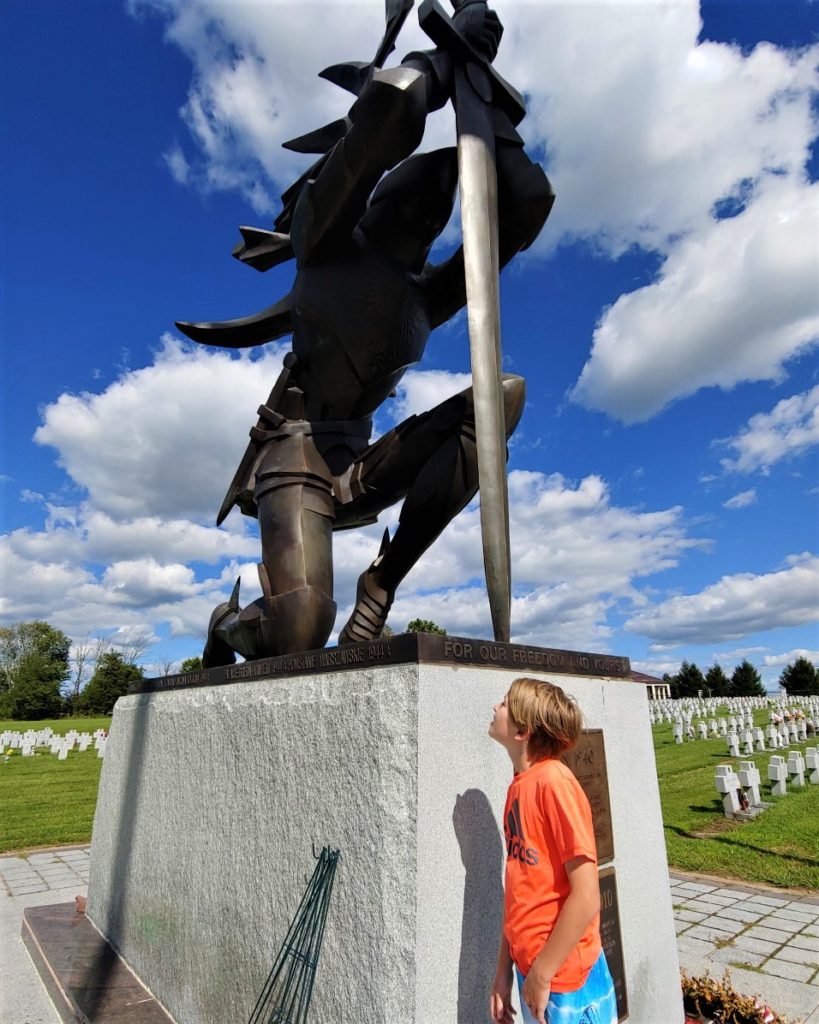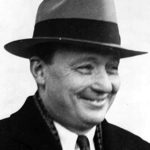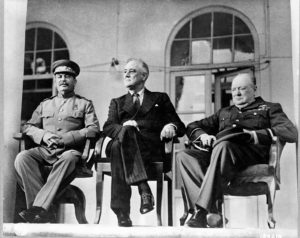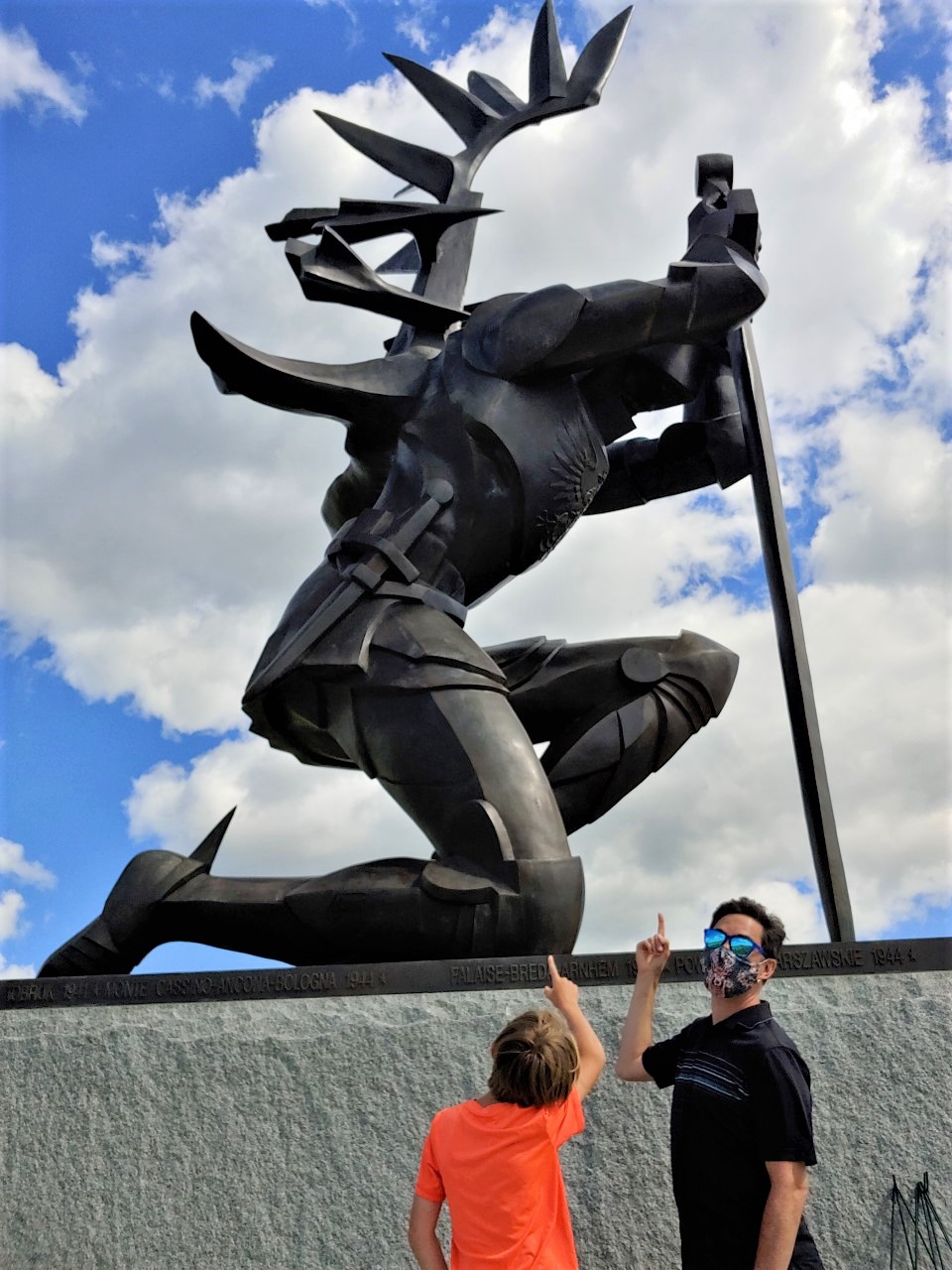Bucks statue recalls heroism, a massacre, a governor and a 50-year coverup.
The statue is startling in Central Bucks County. It seemingly portrays a super hero of the kind you find in graphic comics that grandson Dashiell might enjoy. Indeed, he and younger sister Margaux stood transfixed in our visit. “Cool!” declared Dash, staring up at a helmeted soldier with wings kneeling with an outstretched sword. The 30-foot-high effigy is not the product of fantasy. It depicts a real-life warrior from Poland sent to Vienna in 1683 as part of an elite 3,000-man cavalry to save Austria and Europe from invasion by 300,000 Turkish foot soldiers. I explained the story to the kids, showing them an 1810 painting of the Hussars in battle charge. They were horse soldiers equipped beyond belief: Feathered wings 4-feet-long fastened to their armor. Eighteen-foot-long lances. Rifles and bows strapped to their backs. Four large pistols each. Knife-like swords capable of piercing body armor. Curved sabers and battle axes. “Imagine that coming at you at full gallop,” I suggested. “No way!”exclaimed the kids in unison. In the end, the Hussars drove a wedge in enemy troops, turning imminent defeat into victory over the Turks.

The statue looms above the cemetery at Our Lady of Czestochowa, the national Polish shrine in New Britain Township. It reminds visitors of the valor of those long-ago heroes. Of interest to me is a tableau on the base. It refers not to 1683 but an event in 1940 in a Polish forest. A man from Haverford 30 miles from the shrine unmasked what happened. But he never lived to see his investigation revealed. President Franklin Roosevelt and succeeding administrations put the kibosh on it.

I came across George Earle’s story while editing a book for Georgetown University a few months ago. Earle dropped out of Harvard as a young man, enlisted in the Army before World War I and joined Roosevelt’s 1932 election campaign. The following year, the president sent him to Vienna where citizens were enamored by Adolph Hitler’s rise to power in neighboring Germany. In presenting his credentials as a U.S. diplomat, Earle announced, “I loathe the Nazis”, creating a bit of a kerfuffle. Returning to Pennsylvania in 1934, he ran for governor and won, the first Democrat to do so in 40 years.
On the eve of World War II in 1939, he rejoined the Roosevelt Administration as a diplomat posted to Bulgaria. When a suspected Nazi spy appeared at the U.S. embassy in Sophia, Earle beat a confession out of him. On another occasion (perhaps inspiration for a scene in the classic movie “Casa Blanca”), Earle was at a Bulgarian nightclub when German officials had the house band play “Horst Wessel Lied”, the Nazi Party’s theme song. Outraged, Earle had the band counter with “It’s a Long Way to Tipperary,” popular among Allied troops in World War I. What followed was a brawl amidst thrown bottles. A delighted Roosevelt proclaimed it the “Battle of the Bottles in the Balkans.”
Afterwards the president sent Earle to Istanbul as an attache reporting directly to him. Hungarian nightclub dancer Adrienne Molnar, an acquaintance, joined him in Turkey. Through her, Earle learned Hitler was preparing to launch “robot bombs” against London. This was a year before V-1 “buzz bombs” began raining down on the city.
In 1944, the president directed him to investigate reports of a mass murder of Polish citizens in Katyn Forest near the Russian border in May 1940. Was it true? Were Nazis responsible? What Earle discovered was very troubling: It was the Russians. After Russia and Germany agreed to divide occupied Poland in September 1939, the Russian army arrested approximately 22,000 Polish citizens. Among them were the Polish military leadership, local police, Catholic priests, factory and property owners, university professors, 300 physicians, several hundred lawyers plus more than 100 writers and journalists. On orders from Joseph Stalin, the captives were shot to death and buried in mass graves.

Earle sent his conclusions to Roosevelt, putting him in a delicate position. The Russians were allies in the war. A public disclosure could harm the alliance. Earle’s report was locked away. Near war’s end Russians publically blamed Nazis for the murders. Earle, wanting the truth to get out, sought permission to write about the atrocity. But Roosevelt forbid it and transferred Earle to Somoa for the balance of the war. He died in 1974, never able to reveal what was in his report. It wasn’t until 1992 the truth finally emerged. To heal a breach with Poland, Russian President Boris Yeltsin admitted what happened and handed over Stalin’s execution orders.
The moral of the story is that governments – even by the people and for the people – all too often gag the truth about inconvenient events.
***
Sources include “The Katyn Controversy: Stalin’s Killing Field” by Benjamin B. Fischer published in 2010 by the CIA; “Post Mortem – The Katyn Story” by Andrzej Mularczyk published in 2007; “Spy Sites of Philadelphia: A Guide to the Region’s Secret History” by H. Keith Melton and Robert Wallace with Henry R. Schlesinger due out in Feb. 2021 from Georgetown University Press, and Our Lady of Czestochowa’s website at https://czestochowa.us/

